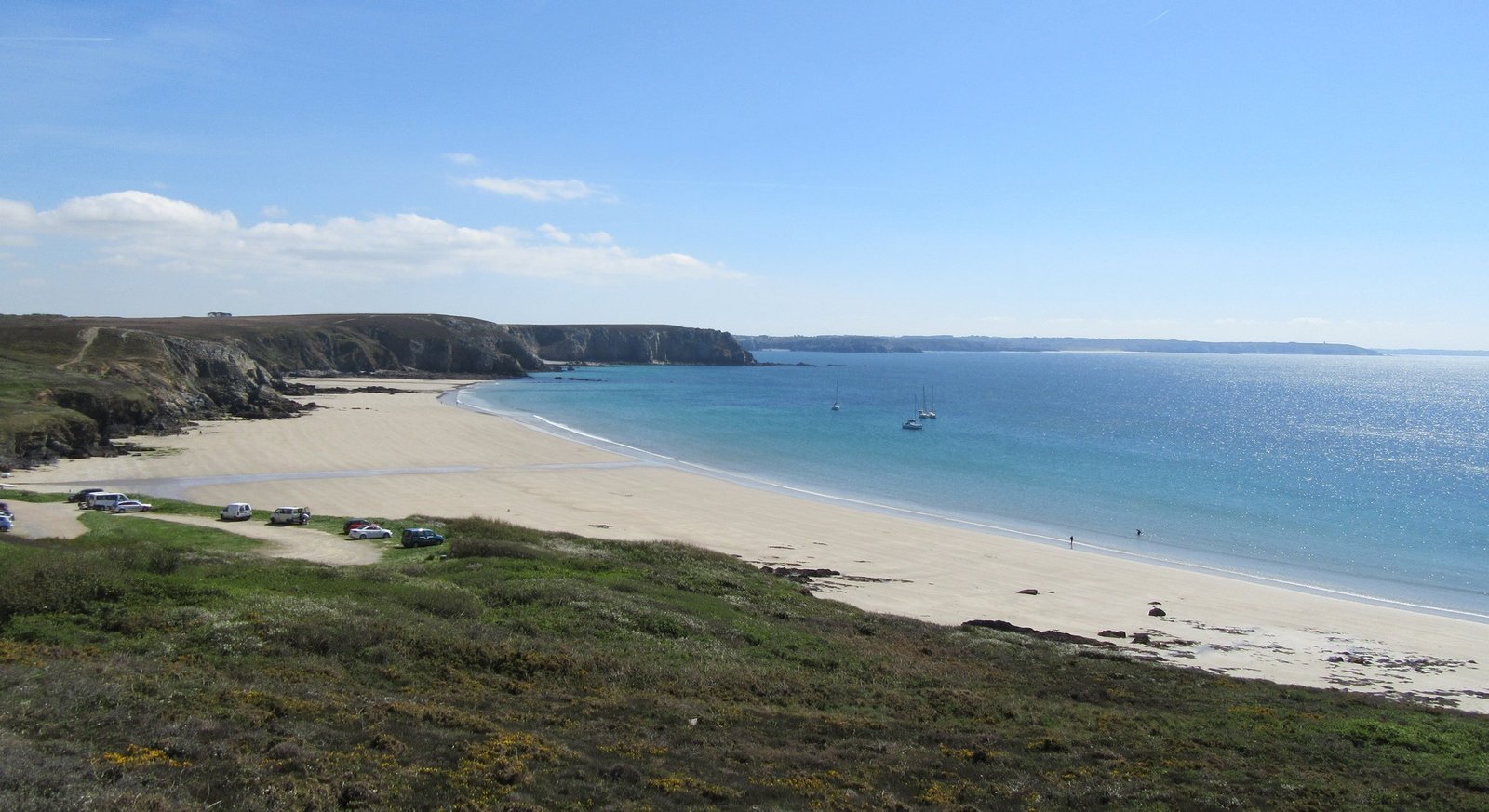Brittany is the French region located furthest to the west of France. It attracts millions of tourists each year, both French and foreign, particularly the British, Germans, and Belgians. The region charms with the diversity of its attractions: the wild coast of Pointe du Raz, the fine sandy beaches of the Emerald Coast, as well as historic cities like Rennes and Saint-Malo, and charming fishing villages such as Locronan and Concarneau. What ultimately stays in the memory of travelers is especially its authenticity and strong regional identity.
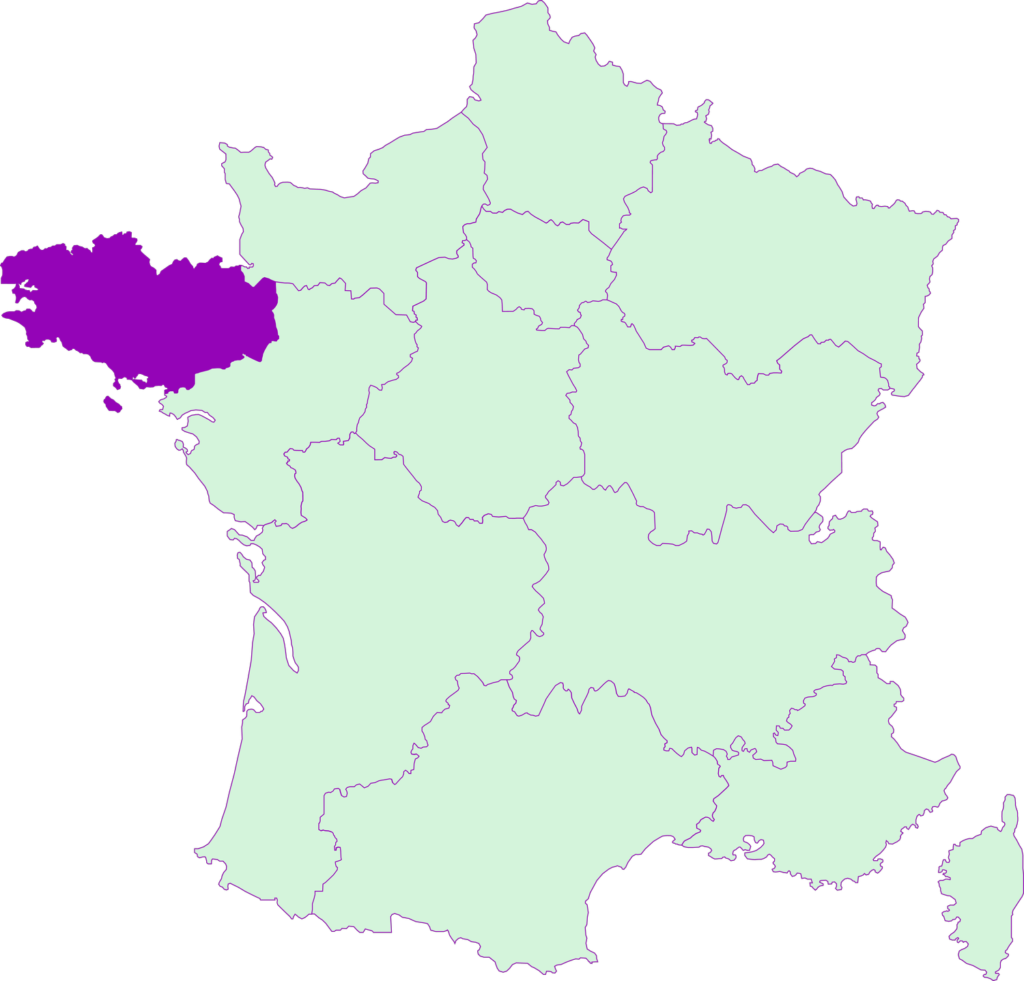
However, to truly appreciate everything Brittany has to offer, a short getaway is not enough. To explore its varied landscapes, savor its cuisine, participate in its local festivities, and understand its history and legends, we recommend staying at least a few months. This time will allow you to discover Brittany in all its splendor and live an authentic and unforgettable experience.
Some socio-economic data about Brittany
Brittany, with its four departments (Ille-et-Vilaine, Finistère, Côtes-d’Armor, and Morbihan), has a notable economic dynamism and an attractive quality of life. Its population of about 3.3 million is continuously growing, attracting many new residents thanks to its pleasant living environment and professional opportunities. The Breton economy is diversified.
Agriculture
Agriculture plays a prominent role here, with the region being France’s leading producer of agricultural and agri-food products, particularly vegetables (cabbages and artichokes in particular), pork, and dairy products. The agri-food industry, with leading companies such as Lactalis and Cooperl, is a major pillar of the regional economy. Despite this, Brittany is not a cheese-producing region. The flagship product is salted butter, which is widely preferred over oil for cooking.
Fishing
Brittany is France’s leading fishing region, with 50% of the national catch and 110,000 tons of fresh fish. Its maritime frontage is the longest in France, stretching over 2,730 km. The most active ports are those of Lorient, Concarneau, and Douarnenez. The port of Guilvinec is, in turn, the leading artisanal port in France. If you want to taste hake, monkfish, pollock, line-caught bass, or seafood such as clams and spider crabs, you’ll know where to go!
Telecommunications
The information and communication technology (ICT) sector is also booming. Today, Rennes hosts many innovative companies and research centers, but the history of telecommunications in Brittany dates back much further.
Brest has a long tradition in telecommunications. In 1861, the first transatlantic telegraph cable connecting Brest to Saint-Pierre-and-Miquelon was put into service. This made Brest a key point for communications between Europe and North America. In 1869, the first telephone connection was established between Brest and Paris. The city then became an important center for military telecommunications with the creation in 1893 of the École supérieure d’électricité et de télégraphie de la Marine, the predecessor of the ENSTA Bretagne (National Advanced Technical School that trains military engineers specialized in telecommunications). During World War II, Brest suffered heavy damage but retained its strategic role in telecommunications. In 1944, the first undersea telephone cable connecting Brest to New York was laid.
After the war, Brest continued to develop as a telecommunications hub, notably with the establishment in 1974 of the École nationale supérieure des télécommunications de Bretagne (Télécom Bretagne), now IMT Atlantique. In 2017, IMT Atlantique and ENSTA Bretagne signed a partnership agreement in the presence of the Lorient-based Minister of Defense, Jean-Yves Le Drian. Today, Brittany has become a key region for technologies such as telecommunications, cybersecurity, and cyber defense.
Tourism
Tourism is another key sector, creating many seasonal and permanent jobs. Renowned tourist destinations such as Saint-Malo, Lorient, Quimper, the Gulf of Morbihan, and the Pink Granite Coast attract millions of visitors each year.
Transport
Brittany benefits from a well-developed transport network, with high-speed lines (LGV) to Paris and other distant cities such as Lille, Strasbourg, and Brussels (Belgium). The Rennes train station remains a central point for the transport of travelers. A new LGV line between Rennes and Bordeaux/Toulouse is expected in 2023.
The TER BreizhGo (Regional Express Transport) operates nearly 350 trains per day and is complemented by BreizhGo buses. You can book your tickets on the SNCF website or through the SNCF Connect mobile app.
The regional road network has a local feature: it is entirely free of tolls and limited to 110 km/h.
There are two international airports, which are not known for being the busiest: Rennes-Saint-Jacques Airport (RNS) and Brest Bretagne Airport (BES). However, it is very easy to travel to Brittany by train from Nantes-Atlantique Airport (NTE) or from various Parisian airports.
The pharmaceutical, biotechnology, and cosmetics industry
Brittany has developed a competitiveness cluster in this sector, allowing it to gradually expand its activities.
- In the pharmaceutical sector:
- Sanofi operates a heparin production site in Ploërmel.
- Panpharma specializes in injectables (anesthetics, antibiotics, and heparins). The company has its headquarters and production site in Luitré-Dompierre.
- CEVA produces veterinary medicines (for reproduction and stress management) in Loudéac.
- IFREMER (French Research Institute for the Exploitation of the Sea) has 5 sites spread along the Breton coastline.
- As for biotechs, a few have emerged in Brittany:
- Biotrial is a recognized CRO specializing in clinical trials.
- Hémarina draws inspiration from nature, particularly from marine worms, to develop molecules that transport oxygen to replace hemoglobin. Today, Hémarina holds patents in various applications such as graft preservation and acute respiratory distress… The company is based in Morlaix, near the Roscoff biological station.
- Cosmetic laboratories are also well represented:
- Yves Rocher, a family multinational that produces plant-based cosmetics and has its own distribution network, has its headquarters in Rennes and its historic headquarters in La Gacilly.
- Omega Pharma produces Phytosun’aroms essential oils and T.Leclerc makeup powders in Plélo.
- COSMED/Bertin also extracts essential oils in Vannes.
- Lessonia produces cosmetics for thalassotherapy establishments in Saint-Thonan.
Learn more about the pharmaceutical, biotech, and cosmetics sector in Brittany
Other notable elements
PSA (Peugeot-Citroën) has a production site in Rennes, and Leclerc shopping centers were established in Lannion.
The Breton Climate
Beware, sensitive topic!
Brittany has the reputation of being a rainy region. The reality is a bit different. Indeed, while it rains more often, the rain is rarely stormy. In terms of total rainfall, it does not rain more in Brittany than in other French regions. In other words, there are fewer storms, and local infrastructure for managing rainfall is better controlled. On this subject, the Bretons have two proverbs:
- In Brittany, it’s sunny several times a day!
- In Brittany, it only rains on fools… (so be careful about what you say about the Breton climate)
To be more down-to-earth, Brittany enjoys a mild oceanic climate. The winters are less cold than in many other regions, and the summers are cooler and more pleasant!
The advice from the Bretons: always keep a raincoat (preferably a Breton oilskin) or an umbrella, a swimsuit, and a beach towel in the trunk of your car.
Breton Culture
Brittany is known for being one of the French regions with a strong identity. Celtic heritage, legends—if you want to make the most of your stay in this region, there are a few basics you should know.
Architecture
When you arrive in Brittany, the first thing you notice are the slate roofs and timber-framed houses. Historically, the slates came from local mines. The timber-framed houses that have stood the test of time are generally listed as local heritage and are protected. They give Brittany’s towns their charm.
The Flag
It is the most visible symbol of Brittany. It is called “Gwen ha Du” (Black and White in Breton). It originates from an earlier Breton flag, the “Kroaz Du” (Black Cross). The creation of “Gwen ha Du” is recent: between 1923 and 1925, by Morvan Marchal, a writer and activist of the Breton independence movement. Today, independence is no longer a major issue, and the “Gwen ha Du” has become the unifying emblem of the Breton people. Whatever gathering you attend in France (protests, concerts…), you will see at least one.
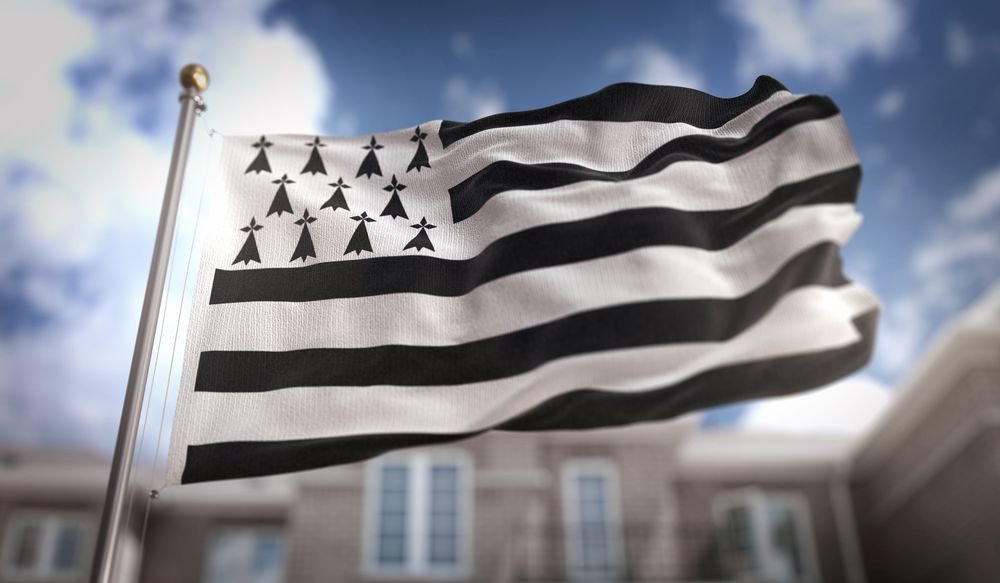
The “Gwen ha Du” consists of nine horizontal black and white stripes of equal width, arranged alternately, and a top section in white dotted with ermine spots. The five black stripes represent the five provinces of Upper Brittany (Dol, Saint-Brieuc, Saint-Malo, Nantais, and Rennais), and the four white stripes represent the four provinces of Lower Brittany (Cornouaille, Léon, Trégor, and Vannetais). Its design is inspired by the flag of the United States… it’s not a legend.
Legends
Legends are an integral part of regional identity. They remind us of the Celtic origins of its people, as Brittany is one of the 6 Celtic nations (along with Scotland, Ireland, the Isle of Man, Wales, and Cornwall).
The Breton legends often originate from Brocéliande Forest, officially known as Paimpont Forest. Among the best-known are the stories of Merlin the Enchanter and the Fairy Viviane. The Arthurian Legends (King Arthur, the Knights of the Round Table, Lancelot du Lac, the Fairy Morgane…), derived from the work of Chrétien de Troyes, also inspire regular adaptations: cinema, comics, parodies (Kaamelott). Less specific to Brittany, but found in Celtic mythology in general, the little people (represented by Korrigans, Leprechauns, fairies…), sirens and the Ankou always end up appearing in legends. It is indeed rarer to find adaptations fully dedicated to them. However, we can mention the Minmoys, Minipouss, the Smurfs, the horror saga “Leprechauns” or the romantic film “The War of the Invisible”

* aka “The Magical World of Leprechauns” aka “The Fairy Menace”, from 1999 with Whoopi Goldberg, Randy Quaid, and Colm Meaney
Want to learn more?
Wikipedia: The article “Breton Mythology”
YouTube: “Legends of France: Brittany – Mysteries and Arthurian Legends”
Contents: The legend of the Emerald Coast, the true story of Surcouf and the Breton privateers, Merlin and the Knights of the Round Table, and the chapel of Tréhorenteuc or the Church of Sainte-Onenne and the Grail
Brittany in Comics
Do we still need to introduce Asterix, Obelix and the village of indomitable Gauls? René Goscinny and Albert Uderzo were supposedly inspired by a coastal village in northern Brittany…
Bécassine is the other star of Breton comics. The comic book tells the story of a naive, clumsy, and poorly educated young Breton woman who moves to Paris to work as a maid in a Parisian bourgeois family. However, she overcomes trials thanks to her peasant “common sense”. While Bécassine is a symbol of Brittany, her popular representation loaded with stereotypes is not always appreciated by the Bretons…
Music & festivals
1950s
In the 1950s, Breton music was very traditional and of Celtic inspiration. The bagadoù (bagad in singular) are musical ensembles emblematic of Breton culture. They are composed of wind instruments (biniou and bombarde), percussion and strings. They organize fest-noz, popular festivities that aim to bring people together and recall fieldwork, its difficulty and the solidarity shown by the Bretons. They are part of UNESCO’s intangible cultural heritage of humanity. The Bagad of Lann-Bihoué, of the French Navy, is the most famous of all, but there are bagadoù in all towns of Brittany.
1970s
In the 1970s, with the influence of World Music, there was a revival of Breton music. Alan Stivell became known for his Celtic harp and the use of electronically amplified instruments. The most famous artists of this period include Alan Stivell (Tri martolod), Gilles Servat (La blanche hermine), Dan Ar Braz and Denez Prigent.
1980s
The 1980s saw the city of Rennes stand out as “The Place To Be”. All artists passed through and the city also became a real “talent incubator”: Pascal Obispo, Florent Pagny, Serge Gainsbourg, Étienne Daho… Today, you can still enjoy this “80s” atmosphere in the night bar “L’Aventure” located in the heart of Rennes, in the former Saint-Michel prison (aka PSM).
1990s
The 1990s made way for Celtic rock with bands like Matmatah, and Celtic punk (Les Ramoneurs de Menhirs).
Today
The musical heritage can still be experienced at fest-noz all over Brittany, at the Cornouailles festival in Quimper or at the Lorient Interceltic Festival (with the Great Parade of Celtic Nations) in August.
If you’re a rock fan, you may already know the Vieilles Charrues festival which takes place in Carhaix (Finistère) around mid-July. This festival attracts 1 million visitors every year and has diversified with pop, electro, hip-hop, world music, or even folk. The program is international, but Breton and Celtic bands are always represented.
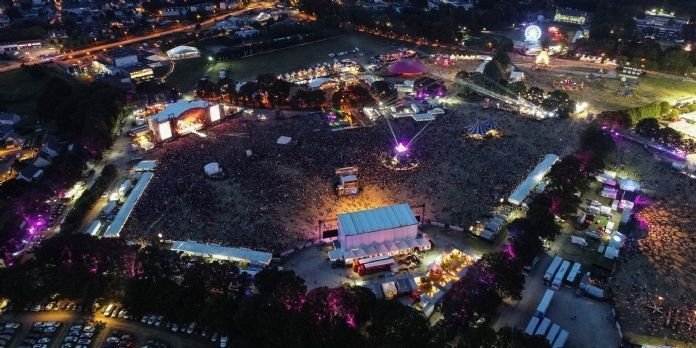
Finally, in December, you can attend the Trans Musicales in Rennes. The program is a bit more pop and electro, but the festival still has a reputation as a springboard for artists.
Maritime gatherings
Brittany is the perfect example of a region between land and sea. The land represents the Bretons’ anchorage to their region and the sea represents escape. This is the advantage of having the longest coastline in France. Between nautical races and gatherings of old rigging, you can take the opportunity to see the sea from a different perspective.
Some races:
- La Route du Rhum: Departure from Saint-Malo towards Guadeloupe, late October every 4 years.
- Le Spi Ouest-France is the largest spring regatta for habitable sailboats in Europe. It takes place every year at the end of March, starting from La Trinité-sur-Mer
- La Transat AG2R La Mondiale is a double-handed race on 50-foot (15-meter) sailboats that connects Concarneau to Saint-Barthélemy in the Caribbean. It starts in mid-April every two years.
- La Drheam Cup is an offshore race that starts from Cherbourg and arrives in La Trinité-sur-Mer. It takes place every 2 years in mid-July.
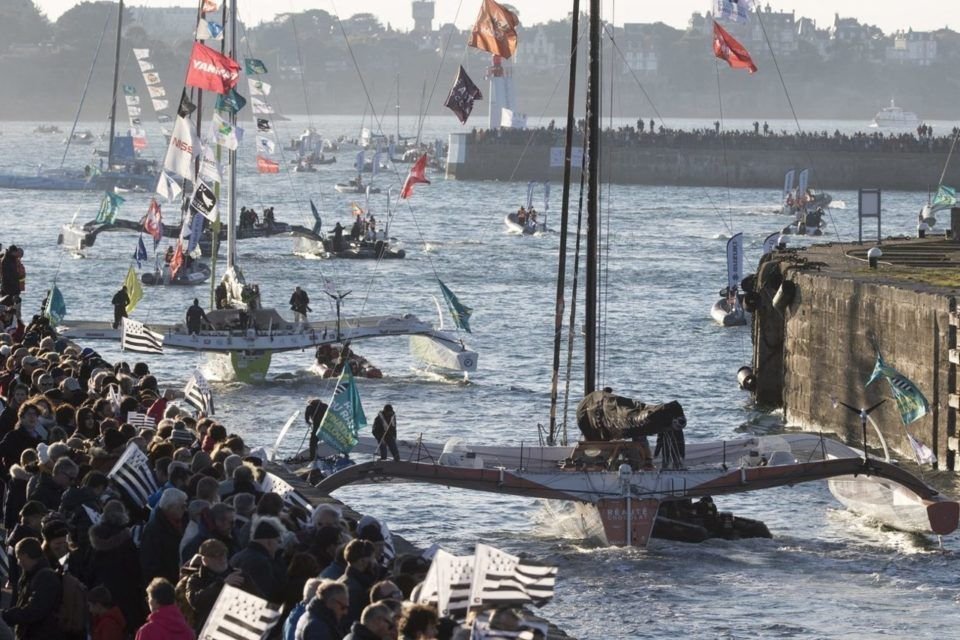
Gatherings of old rigging:
- The Old Rigging Festival of Paimpol: late August
- The International Maritime Festival of Brest: in July
- The Gulf Week in Morbihan: late May
The language
In Brittany, the official language is French. You will therefore not have to learn another language if you come to work in Brittany. However, there are two regional languages in Brittany: Breton (mainly in Lower Brittany – the westernmost part) and Gallo (mainly in Upper Brittany, to the east). Breton enjoys a more established status than Gallo, but both regional languages of Brittany are the subject of preservation and promotion efforts by regional authorities. Among these measures is the establishment of Diwan schools, public schools where teaching from kindergarten to high school graduation is conducted primarily in Breton.
Breton first names
Breton first names may require the most effort from you. Here are a few to help you prepare.
Male Breton first names
Maël
Yann
Erwan
Gwenaël
Goulven
Gwendal
Tugdual
Brieg
Brieuc
Fañch
Meriadeg
Pol
Ewen
Gwen
Gwilherm
Josselin
Malo
Arthur
Female Breton first names
Enora
Enola
Éva
Nolwenn
Maëlle
Maïwenn
Maëlys
Maïa
Gaëlle
Gwenaëlle
Gwenn
Gwenola
Gwladys
Hélène
Jeanne
Katell
Lena
Rozenn
Soazig
Soizic
Solenn
Armelle
Some vocabulary words in Breton
Demat : Hello
Kenavo : Goodbye
Yec’hed mat : Cheers/Health
Mamm-gozh : Grandmother
Fest-noz : Night festival
Biniou : Breton bagpipe
Breizh (BZH) : Brittany
Brezhoneg : The Breton language
Gwenn ha du : Black and white
Dour : Water
Mor : Sea
Ar mor : Coastal part of the sea / Seaside (Armorica is the land by the sea)
Morbihan : Small sea, gulf
Menhir : Standing stone
Menez : Mountain
Amann : Butter
Kouign-amann : Butter cake
Lux : Light
Glav : Rain
Understanding village names
Breton towns and villages sometimes have a reputation for having unpronounceable names. When you understand their origins, it becomes simpler. When you come to work in Brittany as a healthcare professional, you will be able to better understand and read the road signs.
Aber : Estuary / river mouth / transition zones between land and sea. The northwestern tip of Finistère is sometimes called the “land of abers”.
Examples: Aber-Wrac’h, Aber Benoît…
Ker : Town / Village / Home
Examples: Kernével, Kervignac, Kerlaz, Kerien, Kerbors, Kergloff…
Plou / Plo / Ple: Parish / Rural community / Territory / Domain
Examples: Plouguerneau, Plouha, Plouézec, Plougastel, Plouguerneau, Ploudaniel, Pleubian, Plomeur
Lan(n): Hermitage, sacred place
Examples: Landivisiau “hermitage of saint Thivisiau”, Lamballe “hermitage of Paul”, Laurenan “hermitage of Ronan”…
Loc: Holy place, hermitage, monastery dependency
Examples: Locolven “place dedicated to Goulven”, Locminé, Locqueltas, Locmiquélic, Loctudy, Lochrist, Locmariaquer…
Gastronomy
The region is especially famous for its crêpes and buckwheat galettes, served in its countless crêperies. Accompanied by Breton cider, they make for a convivial and flavorful meal. The galette-saucisse, an emblematic snack particularly popular at sporting events and markets, combines a hot buckwheat galette wrapped around a grilled farm-raised pork sausage. Plain, with onions, with or without sauce, it’s the Breton street-food experience not to be missed! At restaurants, the most classic galettes are made with ham-egg-cheese, but the combinations of ingredients are endless. If you like stronger flavors, you could replace the ham with Guémené andouille sausage, for example.
Main dishes
Seafood and fish also hold a special place in Breton gastronomy. From generous seafood platters to oysters, to Cancale’s bouchot mussels, spider crabs and freshly caught cockles, if you’re a fan of sea flavors, you’ll be delighted. Fishing is at the heart of Breton culture, and this is reflected in the quality and diversity of the products offered.
Scallops, often prepared simply to highlight their natural sweetness, are another local specialty not to be missed. The port of Erquy has the reputation of being the capital of scallops. If you want to taste a more renowned dish, you can always try lobster à l’armoricaine. If on the contrary you want to explore Brittany with a sandwich, consider sardine rillettes with some pickles.
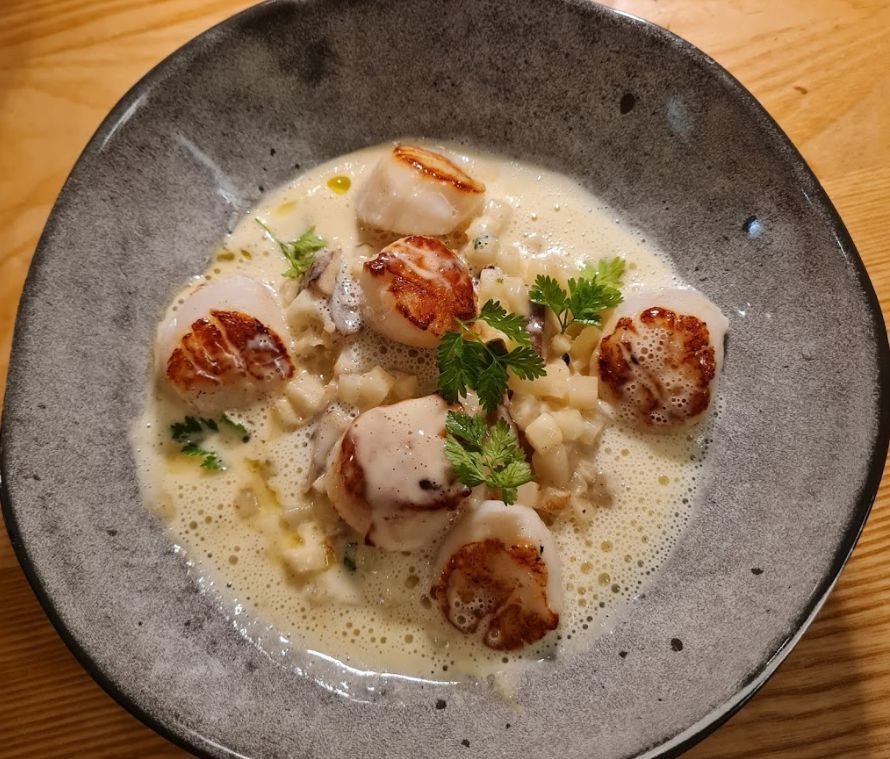
Among traditional dishes, kig ha farz is a must-try. This rustic dish from Finistère consists of a meat stew (usually beef and pork) accompanied by farz, a kind of pudding made from buckwheat or wheat flour, all cooked in an aromatic broth. This hearty dish perfectly reflects the authenticity and generosity of Breton cuisine. If you’re looking for a finer beef dish, opt for a chateaubriand with its shallot-based sauce.
Desserts and cheeses
Here again we find the authenticity of Brittany: simplicity and taste. The most well-known desserts are obviously sweet crêpes, but another basic is far breton. It’s a prune flan often served warm. Salted butter caramel is another ultra-addictive local specialty. It accompanies and literally elevates many desserts, whether chocolate or fruit-based. But the star of Brittany remains undoubtedly kouign-amann, a dessert with more texture than a croissant and caramelized flavors. Sold in a good bakery, an artisanal kouign-amann guarantees 100% positive reviews.
Finally, the cheeses. Although Brittany is a dairy region, it does not have AOC cheeses. If you want a mild local cheese, Timanoix is particularly recommended. It’s aged in walnut liqueur, which gives it mild aromas and a pronounced yellow color.
Beverages
Cider, of course, to accompany galettes. Another local drink is chouchen, a sweet alcoholic beverage as it’s a mead (fermented alcohol made from honey). As with cheese, you won’t find (or very few) Breton wines, but the region produces a number of beers. One to try: Mor Braz, brewed with water from the Iroise Sea, in other words, a salty beer!
In the non-alcoholic section, it’s notable that the most sold cola soda is Breizh Cola!
Ribot milk is also a very interesting local product. It’s a fermented raw milk, rich in proteins and probiotics beneficial for digestive health. It’s easily digested because the added lactic ferments consume the lactose before tasting. Children love it and it can also be used to cook desserts.
Local markets
Brittany being a region rich in agriculture, livestock farming and fishing, Breton markets are particularly well-stocked. Whether in Quimper, Vannes or Saint-Malo, you can find a wide variety of fresh and local products, allowing you to discover the richness of regional gastronomy. The market at Place des Lices in Rennes is one of the largest and most beautiful markets in France. You can find everything there, products from around the world, various food trucks and the famous galette-saucisse!
Check the days and hours, as in France, markets are not held daily!
Tourism in Brittany
The subject is simply inexhaustible. Brittany has many well-known tourist sites, but also many more discreet gems. To make the most of them, you will need to add the results of your own research to the classic tourist advice.
Here are our tips to make the most of your long-term stay in Brittany.
- Use the tourism office website of Brittany and download their maps to prepare your stay. Their website is remarkably well structured to help you organize your outings. The main areas of interest are clearly presented.
- If you come to work for several months as a healthcare professional, take the opportunity to get information from your colleagues! (The tourism office website is sometimes incomplete…)
- Don’t hesitate to go beyond the borders of Brittany and visit Mont St Michel in the North and the Loire region further south (the point of Croisic, Batz-sur-mer, La Baule (more touristy), and Nantes).
- Don’t just target one city, but an area. For example, don’t just visit the corsair city of Saint-Malo, but take an extra day and take the opportunity to visit some emblematic cities and beaches of the Emerald Coast: Dinard (The chic English town), Saint-Briac, Saint-Lunaire and its ultra-fine sand beach, Saint-Cast, Erquy. Don’t hesitate to take time for a short hike between the cliffs of Cap Fréhel and Fort La Latte.
- Get off the beaten track and opt for slow tourism. Being there for several months, you’ll have more time to visit than during a traditional vacation. Take advantage of it, take your time!
- Organize yourself to be able to visit the North, center, and south of Brittany. If you cross Brittany from North to South or vice versa, take the opportunity to visit Rennes, the Paimpont forest (or Brocéliande forest) and the Arrée mountains.
The 10 areas of Brittany to know for a well-organized Work & Travel
The distribution made by the Brittany tourism office being ideal, here is a small synthesis

The center of Brittany
1 – Rennes, the most student-friendly and trendy city, just 1.5 hours from Paris by TGV.
To enjoy the market at Place des Lices, you need to go on a Saturday morning. On the first Sunday of each month, at the central market hall, the “food market” is organized, perfect for visiting Rennes during an extended weekend.
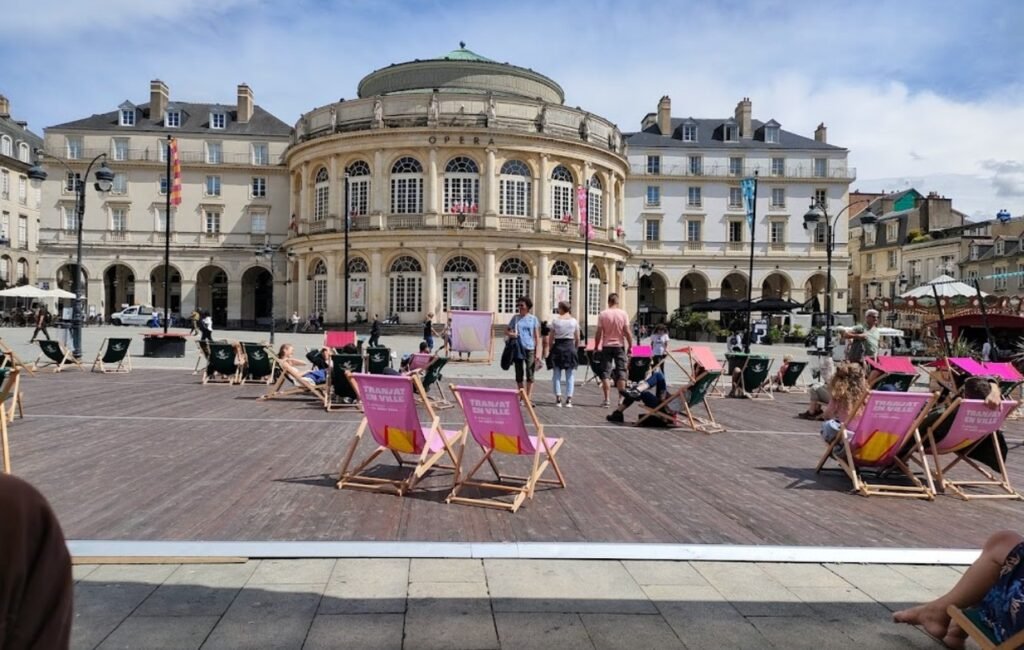
Must see: the pedestrian center, Place Sainte-Anne (with its restaurants, Saint-Aubin Basilica, the Jacobins Convent (transformed into a conference center and tourist office), Rue Saint-Michel (aka “Thirst Street” for students), the old Saint-Michel prison), the library of the Parliament of Brittany (which can be visited since its reconstruction after a fire in 1994), Saint-Pierre Cathedral and the Mordelaises gates. Finally, if you like cycling, hiking or jogging, it is very easy from Rennes to go for a walk along the Ille-et-Rance canals.
2 – The Brocéliande Forest and its legends, for a “nature” outing
3 – The Arrée Mountains and their exceptional landscapes
The Northern part of Brittany
4 – The Pink Granite Coast and the Bay of Morlaix
As its name suggests, it is indeed the colors of the stones that make the landscapes of the Pink Granite Coast so romantic. Don’t forget to stop by Roscoff and its exotic botanical garden. Summer tourists love to visit the Barnenez Cairn, the beaches of Plestin-les-Grèves, the charming villages of Carantec and Perros-Guirrec… Photography enthusiasts will find at the eastern limit of this area “The Bay of Hell” and its marine cemetery.
5 – The Bay of Saint-Brieux
Its eponymous city, Paimpol, Erquy (capital of the scallop) and Dinan are the main cities. Nature lovers can reach Cap Fréhel and Fort La Latte by hiking. Food lovers will find restaurants with authentic and renowned cuisine. As you get closer to the very “chic” Dinard, don’t forget to stop at one of the many fine sandy beaches to experience “longe-côtes” (walking with your feet, waist, or even chest in the water).
6 – From Saint-Malo to the Bay of Mont Saint-Michel (in Normandy)
Between the beaches of the Emerald Coast, which owes its name to the particular reflections of the sea, and the history-laden cities of Saint-Malo and Mont Saint-Michel, prepare to be amazed.
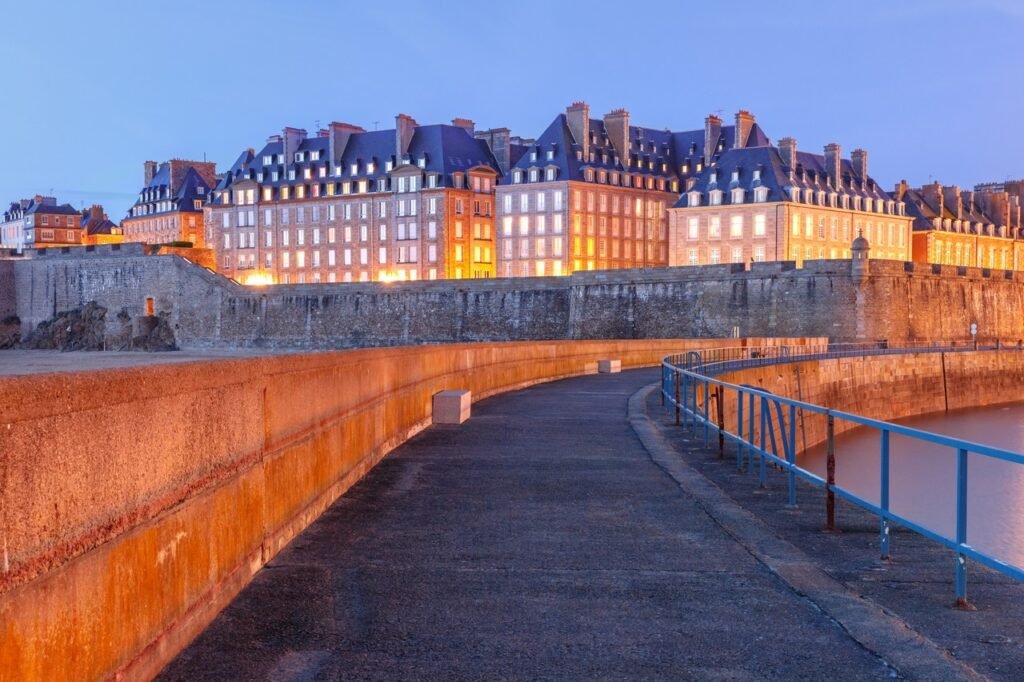
The southern part
7 – Loire-Atlantique: Nantes, Saint-Nazaire, La Baule, Guérande.
Some will tell you that it’s not Brittany, others that the history of Nantes and Anne of Brittany are proof to the contrary. Whatever the case, if you happen to work for a few months in Brittany, this area is worth the detour. Nantes is the largest city on the Atlantic side. Repentant Parisians are many who choose it for a new, less hectic life. Guérande and its salt marshes provide “Red Label” salt to the best French restaurants. The towns of the Côte d’Amour are highly sought-after tourist destinations in the region (Pornichet, La Baule, Le Pouliguen, Batz-sur-mer, Le Croisic, Piriac-sur-mer).
8 – The Gulf of Morbihan, Lorient, Auray, Vannes, Carnac, the Quiberon peninsula, the Étel ria, Belle-île-en-mer and the island of Groix.
This part of Brittany has a reputation for having a particularly pleasant microclimate. Whether between the islands of the Gulf of Morbihan or in the Bay of Quiberon, water sports are particularly popular. Coastal sailing is here, another way to navigate.
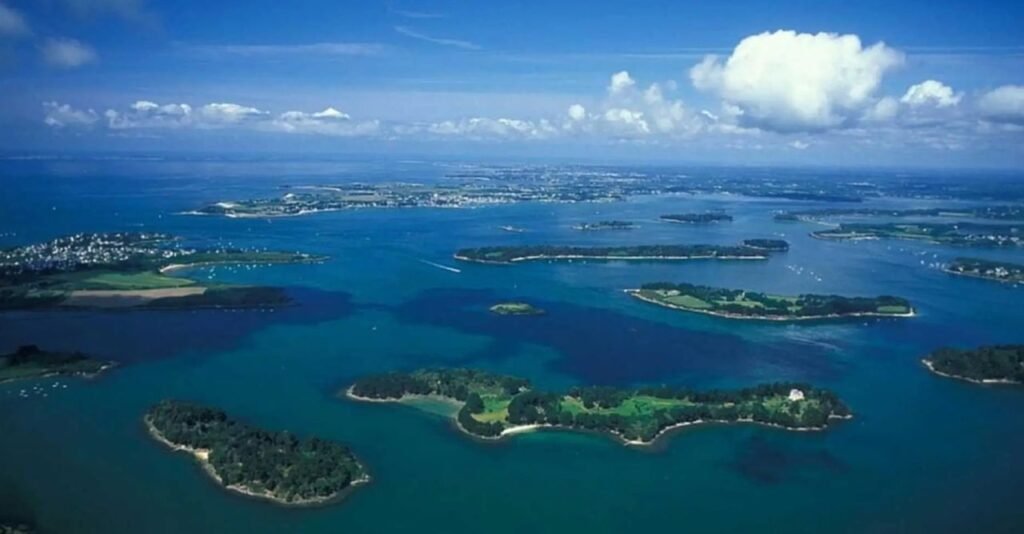
Even if it’s possible to find menhirs all over Brittany, the alignments of Carnac are a must-see attraction. Finally, and if you find yourself near the Gulf of Morbihan in early August, it would be senseless not to attend the world’s largest gathering of Celts at the Interceltique Festival in Lorient.
Finistère: the Western tip of Brittany
9 – Southern Finistère: Quimper, Cornouaille, the Bigouden region, the painters of Pont-Aven, Breton costumes and their famous headdress… it’s all said, or almost.
Indeed, Quimper is the historical capital of Cornouaille and the Pays Glazik, thanks in particular to its former port which sailors accessed by going up the Odet. Its pedestrian center is simply magnificent, with its ramparts and the Gothic Cathedral of Saint-Corentin. You can find two quality regional museums there: the Museum of Fine Arts (partly Breton arts) and the Breton Departmental Museum which will allow you to better understand the history of Brittany. You can see male and female Breton costumes there, including the world-famous Bigouden headdress. For shopping, you can find in Quimper the headquarters as well as a factory store of the Armor Lux brand, which makes clothing in the “Breton” style: Wool sweaters, smocks, peacoats, striped shirts…
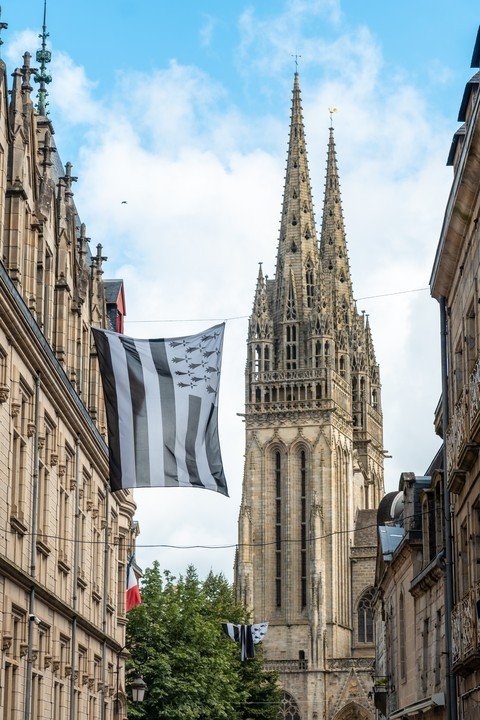
Besides Quimper, Southern Finistère holds many beautiful surprises for those who come to visit. From north to south, here’s what you can find:
- Douarnenez, a sardine fishing port that saw the development of many canneries like Connétables, which marked the economic history of the region in the 20th century.
- The Pointe du Raz, at the western end of Cap Sizun in Finistère, is the westernmost part of mainland France. Its breathtaking panoramas of the Atlantic Ocean have made it a true regional attraction.
- La Torche Point: One of the most renowned surfing spots in France, popular with both windsurfers and surfers for its ideal wind and wave conditions.
- The Hénaff House Museum in Pouldreuzic traces the history of this family business of preserves and pâtés, famous for its Hénaff pâté. Textured and flavorful, its composition allows it to have proper nutritional information (for a pâté): a basic to try.
- Saint-Guénolé, in the commune of Penmarc’h, is famous for its singularly shaped rocks sculpted by erosion, particularly the famous rhinoceros rock.
- Le Guilvinec, the first artisanal fishing port in France, houses the Haliotika museum, which allows visitors to discover local fishing trades and techniques through interactive exhibitions.
- Concarneau has a well-preserved medieval city center, called the Ville Close. It is surrounded by fortified ramparts that encircle this jewel of Breton heritage for a length of about 980 meters.
- Pont-Aven, capital of the Bigouden country, is famous for having inspired Paul Gauguin and his post-impressionist movement: “the Pont-Aven school”. In turn, the “Traou Mad” biscuit factory used the artist by decorating their boxes with his paintings…
10 – Northern Finistère: Brest, the land of abers, the islands of Molène and Ouessant
Northern Finistère is separated from Southern Finistère by the Black Mountains. Their name is due to the color of the different rocks that compose it, such as slate. If you hike in the region, you can find old quarries testifying to a rich industrial history.
Brest is the economic engine of Finistère thanks to the naval base of the National Navy and a port with diversified activities (maritime transport, ship repair, marine renewable energies, fishing, etc.). The Bay of Brest is another place in Brittany that attracts sailing enthusiasts. It hosts the International Maritime Festival every 4 years, an unmissable event bringing together the most beautiful boats from around the world. Finally, the Cité des Télécoms in Pleumeur-Bodou, not far from Brest, allows visitors to discover the history and challenges of telecommunications, a key sector of the local digital economy.
Northern Finistère, beyond Brest
The Crozon Peninsula, a true jewel of Finistère, is full of breathtaking natural sites. The Pen-Hir Point, with its steep cliffs and jagged rocks, offers a striking panorama of the Iroise Sea. Not far from there, the fine sandy beaches of the peninsula, such as the paradise-like Trez Bellec beach, invite relaxation and swimming. The Pointe des Espagnols, meanwhile, reveals a unique landscape of flowering moors and rocks sculpted by the wind.
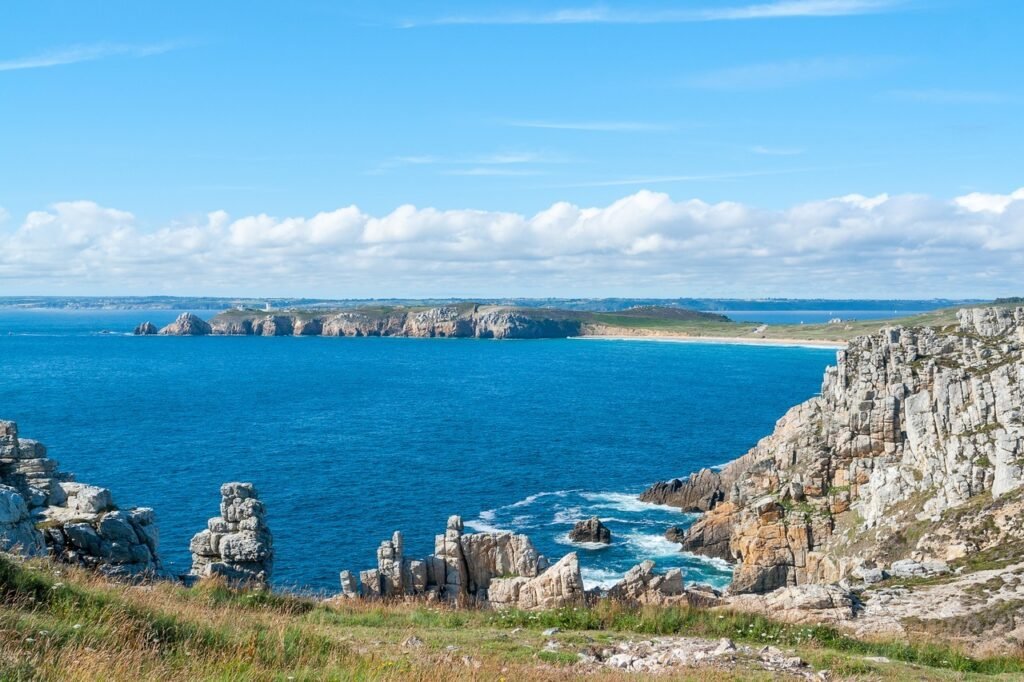
North of the peninsula, Le Conquet and its abers – Aber Wrach, Aber Benoît and Aber Ildut – constitute a natural setting conducive to oyster farming, thanks to their mixture of fresh and salt water. These preserved sites offer a total change of scenery. The islands of Molène and Ouessant, accessible from Le Conquet, allow for a day’s escape. Finally, the more athletic will visit the virgin island and climb to the top of its lighthouse, the highest in Europe.
Must-do Activities
Relaxation Mode
Visit the most beautiful cities in the different parts of Brittany. Take the opportunity to pause in one of the several botanical gardens: in Roscoff the most exotic one, in La Gacilly the most “cosmetic” one, and the Thabor Park in Rennes, the most “pharmaceutical” one.
Leisure Mode
Follow some stages of the hiking trails (more details on the website of the French Hiking Federation) and take the opportunity to visit one of the most beautiful islands of Brittany.
- the GR®34 or customs officers’ path. It is the most frequented and goes all around Brittany. If you can’t walk it entirely, try to do at least two or three stages during your stay!
- the GR®37, crosses Brittany through its center and width. The emblematic passage points are Mont-Saint-Michel, the Brocéliande forest, the Monts d’Arrée and the Crozon peninsula.
- the GR®39 from north to south, along the Vilaine river, from Mont-Saint-Michel to Loire-Atlantique. You can deviate from it to reach, for example, Saint-Malo via the Ille and Rance canal. The GR®39 is very suitable for cycling and jogging (straight lines, little elevation change and shoulders. If you cross Brittany and pass by the GR®39, try to find a stopover area, they are numerous and pleasant.
- the GR® de Pays such as the tour of the Malouin region or that of Belle-île-en-mer
During these hikes, you will be able to discover the most beautiful dolmens, menhirs, cairns and tumuli of Brittany
Gourmet Mode
Try the most iconic specialties and learn to cook with salted butter.
Festive Mode
The simplest way will be to participate in a Fest-Noz. But you can also enjoy Brittany for its numerous musical and nautical gatherings.
Attend the Rennes-Guingamp derby or simply a football match at Roazhon Park. You might even bump into the club owner, François-Henri Pinault (Gucci, Yves Saint Laurent, Balenciaga for the most well-known brands of the small family business) and his Mexican wife, a certain Salma Hayek.
Useful Links
For seasonal news and beautiful photos, here are the websites of the tourist offices of the 4 Breton departments, their Facebook and Instagram accounts
Ille-et-Vilaine
Côtes d’Armor
Morbihan
Finistère
Video collection to prepare your explorations
It is now possible to easily find many videos on YouTube to enrich your knowledge before exploring Brittany. To begin your experience well, here are some videos in the “discovery” category from the public media group France Télévision:
Échappées belles (The most travel-oriented)(France 5)
- Gourmet Brittany
- Brittany, a new energy
- The Ponant Islands, from Belle-Île to Ouessant
- Côtes d’Armor: land of the sea
- North Finistère
- Finistère, between land and sea
- Côtes d’Armor: land of the sea
Des Racines et Des Ailes (The most cultural)(France 2)
- Morbihan, between land and ocean
- Treasures of Côtes d’Armor
- Brittany: the archipelago of 7 islands
- The customs officers’ path (GR 34)
- Brittany: the forest of korrigans
- In Brittany, from the Bay of Morlaix to Cap Fréhel (Parts 1 / 2 / 3 / 4 / 5 / 6)
Les Carnets de Julie / Julie Cuisine (The most gourmet)(France 3)
The Spaniards reading this probably already know this
Thalassa (The sea magazine)(France 3)
Les 100 Lieux qu’il faut voir (France 5)
- Ille et Vilaine
- Côtes d’Armor
- Loire Atlantique
- Morbihan
- Cornwall
- Finistère
- The Customs Officers’ Path, a succession of postcards
For those who would like a less Franco-French vision, you can always watch these two subtitled German documentaries from the ARD group
- Urlaub an Frankreichs Atlantikküste in der Bretagne, Wunderschön / ARD Reisen
- Die Bretagne – Frankreichs stürmisches Paradies / SWR Doku
Conclusion
Coming to Brittany for a few days of vacation can be a pleasant and relaxing experience. However, to truly discover the richness of this region, nothing beats a more thorough immersion. As a participant in a HCPeXchange program in Brittany, you can combine work and discovery and experience a unique way of life. You can immerse yourself in the local culture, build connections with your colleagues and locals. It’s the best way to discover authentic activities. This immersion allows you to go beyond being a simple tourist to become an active participant in your stay, and thus experience Brittany from the inside.
Other French regions where you can work as a healthcare professional


